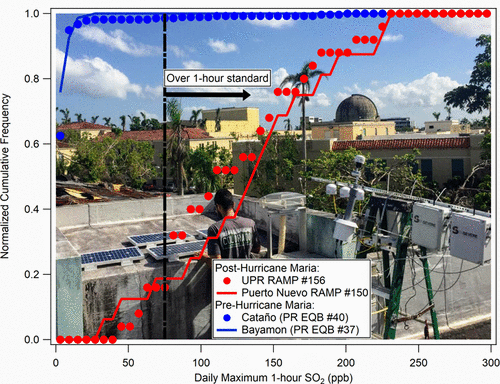当前位置:
X-MOL 学术
›
ACS Earth Space Chem.
›
论文详情
Our official English website, www.x-mol.net, welcomes your
feedback! (Note: you will need to create a separate account there.)
Air Quality in Puerto Rico in the Aftermath of Hurricane Maria: A Case Study on the Use of Lower Cost Air Quality Monitors
ACS Earth and Space Chemistry ( IF 2.9 ) Pub Date : 2018-10-04 00:00:00 , DOI: 10.1021/acsearthspacechem.8b00079 R. Subramanian 1 , Aja Ellis 1 , Elvis Torres-Delgado 2 , Rebecca Tanzer 1 , Carl Malings 1 , Felipe Rivera 3 , Maité Morales 2 , Darrel Baumgardner 4 , Albert Presto 1 , Olga L. Mayol-Bracero 2
ACS Earth and Space Chemistry ( IF 2.9 ) Pub Date : 2018-10-04 00:00:00 , DOI: 10.1021/acsearthspacechem.8b00079 R. Subramanian 1 , Aja Ellis 1 , Elvis Torres-Delgado 2 , Rebecca Tanzer 1 , Carl Malings 1 , Felipe Rivera 3 , Maité Morales 2 , Darrel Baumgardner 4 , Albert Presto 1 , Olga L. Mayol-Bracero 2
Affiliation

|
In the aftermath of Hurricane Maria, the electricity grid in Puerto Rico was devastated, with over 90% of the island without electricity; as of December 2017, about 50% of the island lacked electricity and power outages were common elsewhere. Backup generators were widely used, sometimes as the main source of electricity. The hurricane also damaged the island’s existing air monitoring network and the University of Puerto Rico’s observing facilities. We deployed four lower cost air quality monitors [real-time affordable multi-pollutant (RAMP) monitors] and a black carbon (BC) monitor in the San Juan Metro Area in November 2017. The first month of data collected with the RAMPs showed high sulfur dioxide (SO2) and carbon monoxide (CO) concentrations of varying magnitudes each night. SO2 and CO are strongly correlated (r2 > 0.9) at two sites ∼5 km apart (University of Puerto Rico—Rio Piedras and an industrial area, Puerto Nuevo), suggesting a single source type. BC measured at the UPR site is also well-correlated with CO and SO2. While the RAMPs are not certified as a federal equivalent method, the RAMP SO2 data suggest that the United States Environmental Protection Agency (U.S. EPA)’s daily 1 h threshold for SO2 (75 ppb) was exceeded on almost 80% of the first 30 days of deployment (November–December 2017). The widespread reliance on generators for regular electric supply in the aftermath of Hurricane Maria appears to have increased air pollution in San Juan.
中文翻译:

飓风玛丽亚过后波多黎各的空气质量:使用低成本空气质量监测仪的案例研究
飓风玛丽亚过后,波多黎各的电网遭到破坏,该岛90%以上的地区都没有电。截至2017年12月,该岛约有50%的地方缺电,而停电在其他地方很普遍。备用发电机被广泛使用,有时作为主要电力来源。飓风还破坏了岛上现有的空气监测网络和波多黎各大学的观测设施。2017年11月,我们在圣胡安都会区部署了四台成本更低的空气质量监测仪[实时可负担的多污染物(RAMP)实时监测仪]和一台黑碳(BC)监测仪。每晚都有不同程度的二氧化硫(SO 2)和一氧化碳(CO)浓度。SO 2在距离约5 km的两个地点(波多黎各大学—里奥·皮德拉斯和工业区,波多黎各Nuevo),CO和CO的相关性强(r 2 > 0.9),表明是单一来源类型。在UPR站点测得的BC也与CO和SO 2高度相关。虽然RAMP并未获得联邦等效方法的认证,但RAMP SO 2数据表明,美国环保署(US EPA)每天1 h的SO 2阈值(75 ppb)超过了80%。部署的前30天(2017年11月至12月)。飓风玛丽亚过后,人们普遍依赖发电机提供常规电力,这似乎增加了圣胡安的空气污染。
更新日期:2018-10-04
中文翻译:

飓风玛丽亚过后波多黎各的空气质量:使用低成本空气质量监测仪的案例研究
飓风玛丽亚过后,波多黎各的电网遭到破坏,该岛90%以上的地区都没有电。截至2017年12月,该岛约有50%的地方缺电,而停电在其他地方很普遍。备用发电机被广泛使用,有时作为主要电力来源。飓风还破坏了岛上现有的空气监测网络和波多黎各大学的观测设施。2017年11月,我们在圣胡安都会区部署了四台成本更低的空气质量监测仪[实时可负担的多污染物(RAMP)实时监测仪]和一台黑碳(BC)监测仪。每晚都有不同程度的二氧化硫(SO 2)和一氧化碳(CO)浓度。SO 2在距离约5 km的两个地点(波多黎各大学—里奥·皮德拉斯和工业区,波多黎各Nuevo),CO和CO的相关性强(r 2 > 0.9),表明是单一来源类型。在UPR站点测得的BC也与CO和SO 2高度相关。虽然RAMP并未获得联邦等效方法的认证,但RAMP SO 2数据表明,美国环保署(US EPA)每天1 h的SO 2阈值(75 ppb)超过了80%。部署的前30天(2017年11月至12月)。飓风玛丽亚过后,人们普遍依赖发电机提供常规电力,这似乎增加了圣胡安的空气污染。











































 京公网安备 11010802027423号
京公网安备 11010802027423号